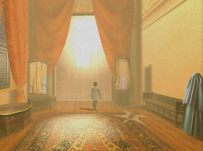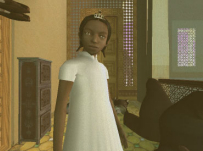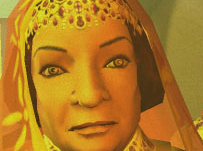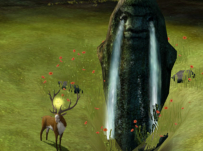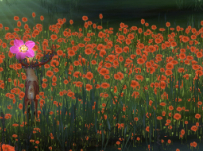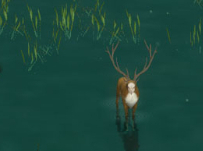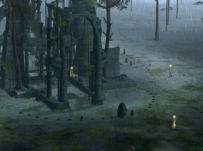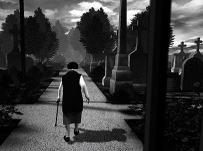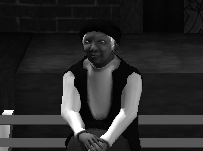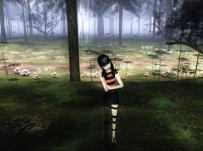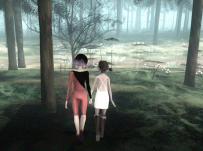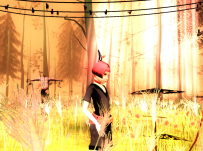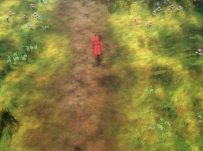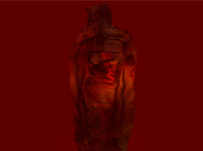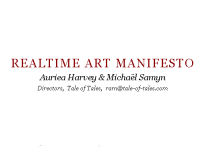Tale of Tales
La Nouvelle Vague

Perfil
- 17 / 03 / 09
Secluded from the intellectual battles waged between different perspectives of the game studies theorists, namely the opposing ideas of narratology and ludology, Auriea Harvey and Michaël Samyn, founders of the studio Tale of Tales, seem to have settled on a middle term, a compromise that regards a new and highly pragmatic vision. Their “Realtime Art Manifesto”, a small document written in 2006, presents a serious challenge to years of presumptions concerning game design, as well as the very definition of the term videogame.
Contrary to many existing independent game studios that aspire to higher steps of the videogame industry hierarchy, Tale of Tales small and independent status is described as the perfect milieu for artists, true freedom of though and the creation of art-games - as opposed to game-art. Relying on digital distribution rather than retailers, the Belgian-based team admitedly focuses their work on a specific audience rather than build complex illusions of conquering the global videogame market. Where other independent studios might lament their reputation and limited means, Tale of Tales understands this status as the only way to preserve artistic integrity.
From the time of its foundation, in 2002, the studio has already provided some interactive models of their unique philosophy. Without exception, each release has shown an adamant sense of ambition, not only because of the actual technical achievement, but because of the revolutionary features that each game contains. THE ENDLESS FOREST is, until the release of THE PATH, the studio’s greatest endeavor: an online experience able to host multiple players drawn together in a mystical forest of unrivaled beauty. Using stags as avatars, the game focuses heavily on a new concept of communication, using visual aids and symbolic actions as an alternative language exercised between participants, thus immersed in a foreign location where the power of communication must be rediscovered.
THE GRAVEYARD, released in 2008, became an icon of the studio’s work as a result of the game’s apparent simplicity and vagueness, ignoring valued parameters in the current game design model such as longevity or replayability. The short tale places the player in control of an old woman crossing a straight and narrow path - an act of abounding symbolism - across a gloomy graveyard. Figuratively surrounded by death, this awkward design choice has been hailed by some as a display of pretence. Yet THE GRAVEYARD is a work for the intellect, modelled for the players who desire to break free from the darkness of the mainstream into the light of art.
The studio’s latest endeavor, THE PATH, is described as a short-horror game that once again captures the forest theme as a background for a contemporaneous reenactment of the traditional tale Little Red Riding Hood. The game appears to present two distinct layers, as seen in the aesthetic contrasts observed in the game presentations: one that mirrors the innocence and infanthood of the characters, resembling a dreamlike world of fairy-tales and everlasting grace; and another stratum that appears to threaten this peaceful picture, inducing an horror element enhanced by the apparent frailty of the all-female cast of juvenile characters, wandering alone in an open space.
It was my pleasure to be able to interview the founders of Tale of Tales. Even the task of interviewing important game designers can become a dreary one: in the case of Michaël and Auriea it was a chance for enlightenment. Not only about the true intentions and ideas flowing around the studio, but about a different part – a new part – of the videogame medium, art or industry (as you like it) that I had not found about before. By providing me substantial and thought-provoking answers as working material, they have also introduced me to new realities and philosophies I knew not exist in the world of computer game creation.
-------------------------------------------------------------
COREGAMERS : Most of what is so fascinating about the studio Tale of Tales seems to originate from the nature of your relationship. In what circumstances did you two meet and when did the idea of creating a studio together started to germinate?
AURIEA & MICHAËL : We met online on 1999, as was the style of the time. We were both very active as web designers and internet artists, Auriea in New York City as Entropy8 and Michael in Belgium as Zuper! We were members of an internet artists collective called Hell.com and we talked to each other for the first time during a research meeting with the collective. It was love at first type.
We started working together the next day and never stopped. First we continued to make websites but in 2003 we switched tools and started exploring the potential of games technology. The actual start of a studio for this was required by the fact that for the first time, we needed funding to do our work. Before, the art we made online was much less work-intensive and could be combined with and funded by design jobs. But working with games technology takes a lot more time. So we started a company as a structure to deal with that business side of things.
CG : Tale Of Tales is a studio founded in a country that has minimal relevance to the videogame industry: while it must feel very rewarding to be among the first, the lack of a videogame design tradition isolates the studio in a distant point of the map. To what extent has this fact affected the growth of your studio?
A & M : We are only part of the videogame industry in as far as is convenient. We never set out to become game developers. We're just artists making things with games technology and we try to use the channels created by the games industry to distribute our work. And it wasn't until we started making games that we became aware of our location. And only because arts funding tends to be localized. Before that, and still to a large extent, our homeland is the internet. Or the world. We don't believe in borders. We're not very interested in the video game design tradition and we also have no interest in seeing our studio grow, at least not economically.
We have experienced, however, certain problems with being from where we are. People sometimes forget about us because we're not in the US or the Netherlands, for instance. But we're not sure if this is because of differences in location or differences in culture and attitude. We don't really belong anywhere. We're not sure if being in another country would change that.
And indeed, it is amusing to be able to call ourselves one of the most important game studios in our country, especially since we're so small.
CG : Do you agree that there was once a great school of European game design? I’ve often discussed this among fellow videogame players and researchers in the field and I’ve come to believe that countries such as France and England played a vital role in the evolution of the media. Where do you stand in this position?
A & M : We're citizens of the world. We've seen interesting games coming from the Americas, from Europe, from Asia. But we're really not an authority on game design history. It only concerns us marginally because we don't see contemporary videogames as only the result of a history of videogames. They're part of a much larger evolution that overlaps with many other areas. All we can see is an embryonic medium that has a hard time growing up. As far as we can tell, any "great school of game design" still needs to happen.
CG : I understand that, apart from designers, you also seem to be avid game players. Certainly you’ve realized how dull most game productions have become lately, in spite of few but powerful exceptions: even the games that seem to be most promising end up revealing structural weaknesses. Sales seem to triumph over artistic vision and innovation most of the times. Do you think that it is possible to create a perfect balance between both?
A & M : We really want to be avid game players. But we sadly are not. There's not a lot of games that we find interesting. This seems to have been to be a little bit better a few years back. But now, as you say, it's mostly quite dull. Unlike in any other creative industry, there is no place for artistic vision in the games industry. As long as artistic vision is not considered the central aspect of game creation and the entire industry is not structured to accommodate for that, balance will be difficult to achieve. It's not even a matter of sales. We all know that original games can sell a lot better than copy-cat games. There's not just a lack of artistic vision. There's also a lack of economic vision.
For all its advances in technology and all its influence on society, the games industry is in fact very conservative and acts like a bunch of small grocery store owners. So in such a climate, the only thing you can do as a forward-looking creative person is to take risks and put commercial interests below artistic ambition. The funny thing is that the majority of games actually fail commercially. So in a sense, making a highly artistic game is not a big risk since the worst that can happen is what happens to most games anyway.
CG : Your studio seems to orbit very far away from financial obligations. How does Tale of Tales manage to stay alive in spite of lacking profitable products?
A & M : First of all, we minimize our costs by remaining small and sustainable rather than requiring constant growth. And second, we make art. When you make art, you can get arts funding. At least in civilized countries. Not a lot of funding, but enough to do your work if you're careful. Some people find art important, even if it's not popular or commercial successful. Those people are smart.
One quick look at the Tale of Tales site is enough to understand how determined the studio is to innovate with its unique artistic vision. Apart from presenting dedicate pages for each project, the site also contains a fistful of interesting interviews made with distinct members of the videogame industry such as Jenova Chen or Takayoshi Sato.
8 (unreleased)
An ambitious project that has not yet seen the light of day, 8 tells the story of a deaf-mute girl trapped inside a palace. Unlike most adventure games, the player does not have full control of the autonomous character that reacts, instead, to the player's choices and the environment. The Endless Forest (2005)
In The Endless Forest, the beauty of the visual environment is only comparable to the impressive game system allowing multiple players to roam freely in a virtual forest where words become meaningless. In order to relate with the remaining stags, the avatars, the player must become acquainted with an original and peculiar language of signs and behaviors. The Graveyard (2008)
Much has been said about The Graveyard, a clear display of the unusual creative force that supports the Tale of Tales studio. Consenting a great amount of subjective interpretation, this uncanny experience deals with themes that are often disregarded and impopular in the videogame industry such as old age and death. The Path (2009)
Scheduled for release on March 18th, The Path is so far the studio's greatest production as can be seen in the actual level of production. Highly atmospheric, this short horror tale portrays six different female characters, of young age, each one of them with a different style and personality. Abandoning old videogame design dogmas, The Path appears to rely heavily on free exploration and introversion instead of mission objectives or high scores. The Kiss Incorporator
The Kiss Incorporator is one of the most illustrative projects by Tale of Tales, a result of the relationship between the two founders. Embracing in an everlasting kiss, the virtual sculpture of two united bodies was actually captured from a real kiss between Auriea and Michaël. Realtime Art Manifesto
The Realtime Art Manifesto is without a doubt one of the most important dissertations introducing videogames as a new and undiscovered form of art. Because of its non-conformist vision, this manifesto alone successfully contradicts hundreds of pages written about the videogame medium in the last decades, while aiming to inspire players, designers and creators to a different perspective of that can be achieved using the computer's ability to generate materials in real time. |


